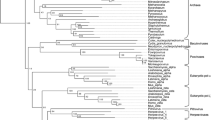Summary
Four Petunia hybrida mitochondrial (mt) DNA fragments have been isolated, sequenced, localized on the physical map and analyzed for their ability to initiate specific DNA synthesis. When all four mtDNA fragments were tested as templates in an in vitro DNA synthesizing lysate system, developed from purified P. hybrida mitochondria, specific initiation of DNA synthesis could only be observed starting within two framents, oriA and oriB. When DNA synthesis incubations were performed with DNA templates consisting of both the A and B origins in the same plasmid in complementary strands, DNA synthesis first initiates in the A-origin, proceeds in the direction of the B-origin after which replication is also initiated in the B-origin. Based on these observations, a replication model for the P. hybrida mitochondrial genome is presented.
Similar content being viewed by others
References
Baker TA, Sekimizu K, Funnell BE, Kornberg A (1986) Cell 45:53–64
Baldacci G, Cherif-Zahar B, Bernardi G (1984) EMBO J 3:2115–2120
Birnboim HC, Doly J, (1979) Nucleic Acids Res 7:1513–1523
Broach JR, Li YY, Feldman J, Jayaram M, Abraham J, Nasmyrit KA, Hicks JB (1982) Cold Spring Harbor Symp Quant Biol 47:1165–1173
Carrillo N, Bogorad L (1988) Nucleic Acid Res 16:5603–5621
Chang D, Hauswith WW, Clayton DA (1985) EMBO J 4:1559–1567
Clayton DA (1982) Cell 28:693–705
Echeverria M, Martin MT, Ricard B, Litvak S (1986) Plant Mol Biol 6:417–427
Folkerts O, Hanson MR (1989) Nucleic Acids Res 17:7345–7357
Fuller RS, Kaguni JM, Kornberg A (1981) Proc Natl Acad Sci USA 78:7370–7374
Gold B, Carillo N, Tewari KK; Bogorad L (1987) Proc Natl Acad Sci USA 84:194–198
Haas JM de, Boot KJM, Haring M, Kool AJ, Nijkamp HJJ (1986) Mol Gen Genet 202:48–54
Haas JM de, Kool AJ, Overbeeke N, van Brug W, Nijkamp HJJ (1987) Curr Genet 12:377–386
Kool AJ, de Haas JM, Mol JNM, van Marrewijk GAM (1984) Theor Appl Genet 69:223–233
Kornberg A (1980) In: Kornberg A (ed) DNA replication. WH Freeman, Plenum Press, San Francisco, pp 379
Kornberg A (1982) In: Kornberg A (ed) Supplement to DNA replication. WH Freeman Plenum Press, San Francisco, pp 89
Li JL, Kelly TJ (1984) Proc Natl Acad Sci USA 81:6973–6977
Loon APGM van, Eijk E van, Grivell LA (1983) EMBO J2:1765–1770
Lowry OH, Rosenbach NJ, Farr AL, Randall RJ (1951) J Biol Chem 193:265–275
Maniatis, T, Fritsch EF, Sambrook J (1982) Molecular cloning, a laboratory manual. Cold Spring Harbor laboratory, Cold Spring harbor, New York
Marunouchi Y, Matsumato K, Hosoya K, Okabayashi K (1987) Mol Gen Genet 206:60–65
Messing J, Vierra J (1982) Gene 19:269–276
Polzkill T, Oliver J, Newton C (1986) Nucleic Acids Res 14:6247–6263
Pring DR, Lonsdale DM (1985) Int Rev Cytol 97:1–46
Sinha P, Chang V, Tye BK (1986) J Mol Biol 192:805–814
Sanger F, Coulson AR, Barrell BY, Smith AJH, Roe BA (1980) J Mol Biol 143:161–178
Stillman BW (1983) cell 35:7–9
Stinchcomb DT, Selker E, Davis RW (1980) Proc Natl Acad Sci USA 77:4559–4563
Struhl K, Stinchcomb DT, Scherer S, Davis RW (1979) Proc Natl Acad Sci USA 76:1035–1039
Wahleithner JA, Wolstenholme DR (1988) Curr Genet 14:163–170
Wallace DC (1982) Microbiol Reviews 16:208–240
Wobbe CR, Weissbach L, Borowiec JA, Dean FB, Yasufumi M, Bullock P, Hurwitz J (1987) Proc Nat, Acad Sci USA 84:1834–1838
Wong TW, Clayton DA, (1985) Cell 42:951–958
Wu M, Lou JK, Chang DY, Chang CH, Nie ZQ (1986) Proc Natl Acad Sci USA 83:6756–6765
Young EG, Hanson MR, Dierks PM (1986) Nucleic Acid Res 14:7995–8006
Zamaroczy M de, Faugeron-Fonty G, Baldacci G, Goursot R, Berardi G (1984a) Gene 32:439–457
Zamaroczy M de, Faugeron-Fonty, G, Bernardi G (1984b) Gene 21:193–202
Zyskind JW, Smith DW (1986) Cell 46:489–490
Author information
Authors and Affiliations
Additional information
Communicated by C. J. Leaver
Rights and permissions
About this article
Cite this article
de Haas, J.M., Hille, J., Kors, F. et al. Two potential Petunia hybrida mitochondrial DNA replication origins show structural and in vitro functional homology with the animal mitochondrial DNA heavy and light strand replication origins. Curr Genet 20, 503–513 (1991). https://doi.org/10.1007/BF00334779
Received:
Issue Date:
DOI: https://doi.org/10.1007/BF00334779




